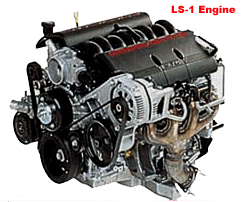 NEW CORVETTE
GENERATION III V8 REDEFINES "HIGH-TECH"
NEW CORVETTE
GENERATION III V8 REDEFINES "HIGH-TECH" With an all-new fifth-generation Corvette on the horizon, the time couldn't be better to introduce the third generation of the legendary General Motors small block V8 engine. Based on a timeless design by former Chevrolet Chief Engineer and General Manager Ed Cole, the "Gen III" 5.7 Liter V8 LS1 marks a bright new chapter in the highly respected lineage that GM small blocks have established for more than 40 years ... with an infusion of cutting-edge technology. Originally introduced in 1955, the small block V8 changed the way people thought about Chevrolet. Virtually overnight, the conservative Chevrolet image became synonymous with high performance. Over the years, the small block V8 has maintained this image, especially because of its use in the high-performance Corvette. With this legacy in mind, GM engineers built the LS1, recognizing this as the opportunity to evolve the small block to the ultimate pushrod V8 engine for the 21st century. The LS1 is characterized by lots of power and immediate responsiveness. It retains the small block's simplicity and elegance of design, while maintaining an exceptionally compact and efficient package size. One of the most exciting LS1 features is its all-aluminum block, designed for stiffness, strength and low mass. A unique crankshaft design and replicated ports improve engine breathing, allowing the engine to fulfill its mission-to produce power! How much power? Try 340 massive horses under the hood and 350 lb.-ft. of raw, tire-grabbing torque.
POWER AND DURABILITY-The LS1 has many refined features that contribute to the overall power of the engine. One of the most notable of these features is the 10:1 compression ratio, which helps maximize LS1's power output. Also, friction-reducing cast-steel roller rocker arms add stiffness to the valve train structure, enabling higher engine speeds. The intake manifold is made of a new lightweight composite material that saves weight and helps air flow more smoothly into the engine, resulting in enhanced performance. The hydraulic roller valve lifters minimize friction for long-lasting durability, and help prevent internal power loss.
NOISE AND VIBRATION REDUCTION-This important engine attribute is enhanced in part by a new accessory drive system. The use of direct-mount accessories and the elimination of fasteners and attachment holes contribute to overall noise and vibration reduction. LS1's hollow-camshaft design also helps reduce noise and vibration.
EMISSIONS-Several features help reduce engine emissions in the LS1. The "coil near plug" ignition system produces high ignition energy, which results in increased combustion and better emissions. The dual-wall air-gap exhaust manifold improves catalytic converter light-off, which helps lower emissions. Also, a sophisticated Sequential Fuel Injection (SFI) system helps make the LS1 emissions-compliant for years to come. Overall, the new LS1 small block features a long list of improvements and new features that fifth-generation Corvette owners will appreciate. These improvements are all designed with one goal in mind: to provide the Corvette owner with world-class sports car performance. With the time-proven small block V8 design to build on, the LS1 is clearly the most technologically advanced pushrod V8 engine GM has ever produced, and is definitely up to the task of powering the legendary Corvette.